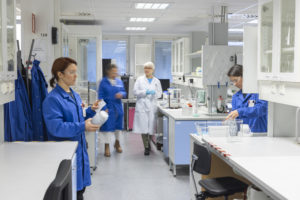Hycamite to produce clean hydrogen and pure carbon from methane
Hycamite has created a technology to split methane into hydrogen and solid carbon without CO₂ emissions. With this technology, the company aims to facilitate the decarbonisation of industry using methane and the transportation of hydrogen.
Hydrogen project article series introduces the projects and perspectives of H2Cluster Finland member companies.

The Kokkola-based Hycamite TCD Technologies is building a hydrogen plant with an annual capacity of two kilotons of hydrogen. This corresponds roughly to the production capacity of an electrolysis plant utilising 20 megawatts (MW) of electricity. Hycamite’s plant, however, is expected to use only one-eighth of the energy needed by a 20 MW electrolyser.
Unlike electrolysis plants, Hycamite’s thermo-catalytic decomposition (TCD) technology uses methane as its raw material. So does the most common method for producing hydrogen, the steam methane reforming (SMR) process, which is known for its high carbon emissions. Hycamite, however, manages to keep CO₂ emissions at zero by using its proprietary catalysts and heat to split methane directly into hydrogen and solid carbon, and by using green energy for the heating.
“Any industrial plant using natural gas or other sources of methane can benefit from our process. Besides replacing an existing steam reforming plant, our process can be added to any type of plant which uses natural gas, biogas or biomethane as a fuel – we can even utilise waste streams from the petrochemical industry. We will turn methane into clean-burning hydrogen,” says Matti Malkamäki, Chairman of the Board of Hycamite.
Malkamäki points out that the new process enables large-scale production of clean hydrogen in places where the supply of green electricity is insufficient for electrolysis plants.
From carbon neutral to carbon negative
Besides providing hydrogen production to new areas, Hycamite aims to participate in facilitating the transportation of emission-free hydrogen from areas with substantial solar or wind power production.
Malkamäki does not expect hydrogen pipeline networks to grow fast enough nor overseas transportation of liquid hydrogen to work out. Another option is turning hydrogen into ammonia, but as a toxic chemical, ammonia requires special safety precautions when transported.
“To avoid issues related to toxicity, Japan, for instance, is already investing in using methane as a hydrogen carrier. Why not use the extensive network already there for natural gas? Hydrogen can be turned to synthetic methane and transported in tankers and pipelines, and finally transferred back to hydrogen with our process.”
The production of synthetic methane requires CO₂, which can be captured from fossil or biobased industries or the atmosphere.
“The final hydrogen produced with our process will be carbon neutral. Hydrogen can even be carbon negative if we use biomethane or synthetic methane made from carbon that has been captured from the atmosphere. We have developed a cutting-edge carbon capture, utilisation and storage (CCUS) technology.”
Malkamäki suggests improvements to the shipping of liquefied natural gas (LNG) or synthetic methane, as well.
“An on-board hydrogen plant provides clean propulsion fuel for any ship using LNG, and the other product, carbon, can be unloaded at the port. We are already developing technology with Wärtsilä Marine Power.”
Carbon nanotubes –valuable products besides hydrogen
The TCD technology developed by Hycamite is based on pyrolysis, that is, a heat-driven process in the absence of oxygen, as all TCD processes are. What makes Hycamite’s process unique is the use of proprietary catalysts.
“Thanks to our catalysts, we are able to produce, besides hydrogen, industrial-quality carbon nanotubes and nanofibers, which are among the most valuable forms of carbon. They are fit for demanding applications, such as batteries, filter purifiers, and even cement,” says Laura Rahikka, CEO of Hycamite.
Hycamite plans to build and operate hydrogen plants owned by investors. Rahikka and Malkamäki are prepared for large and fast projects once the pilot plant is up and running.
“Our primary market will be in the US, where hydrogen solutions are judged by their CO₂ footprint. In Europe, regulation is still unclear and based on technologies rather than CO₂ footprints,” Malkamäki says.



